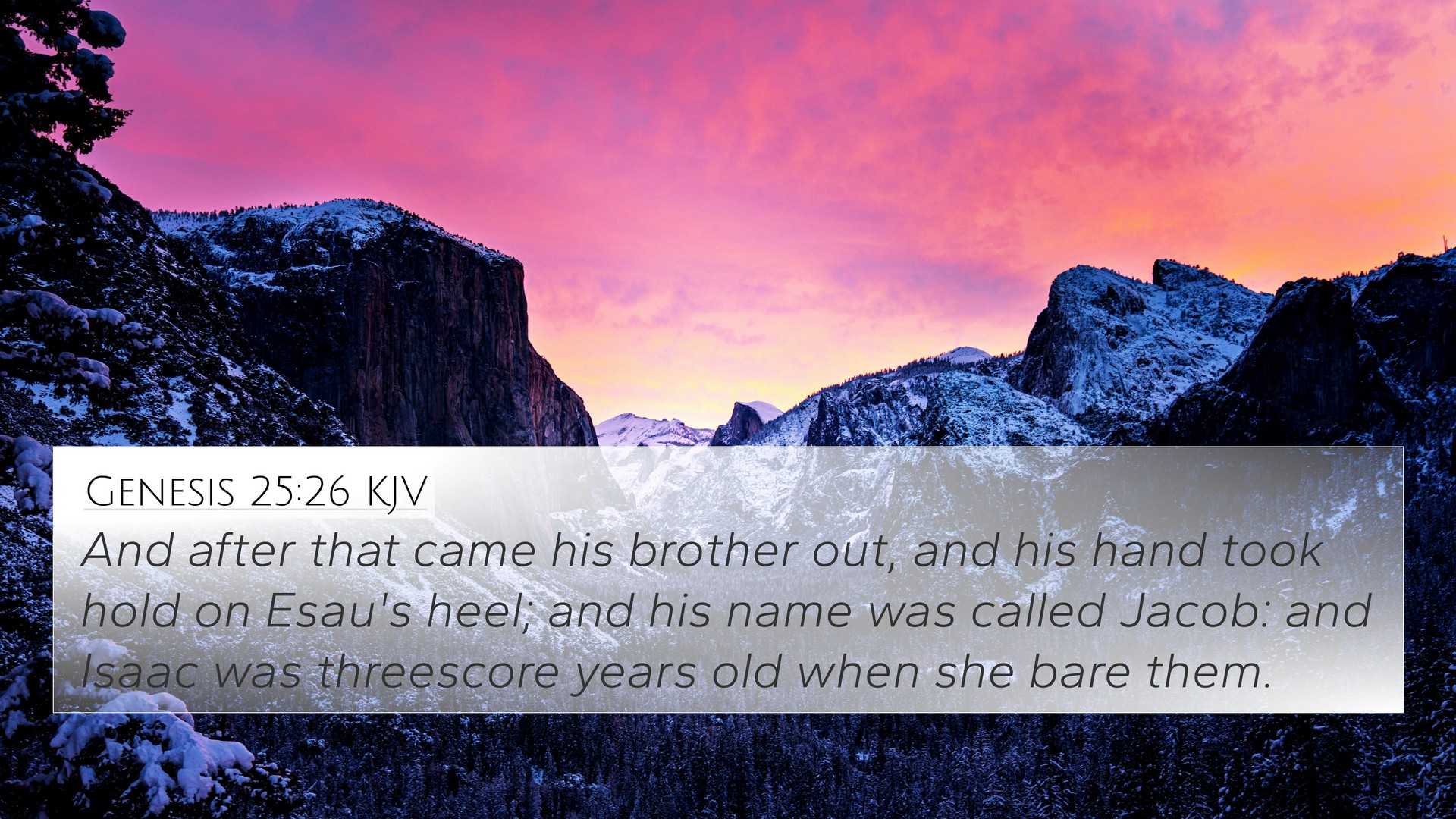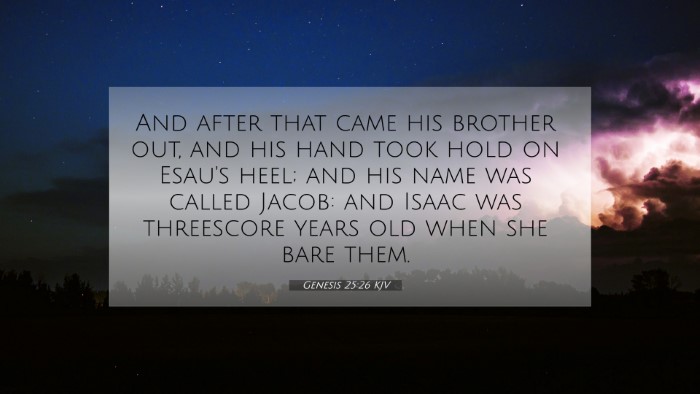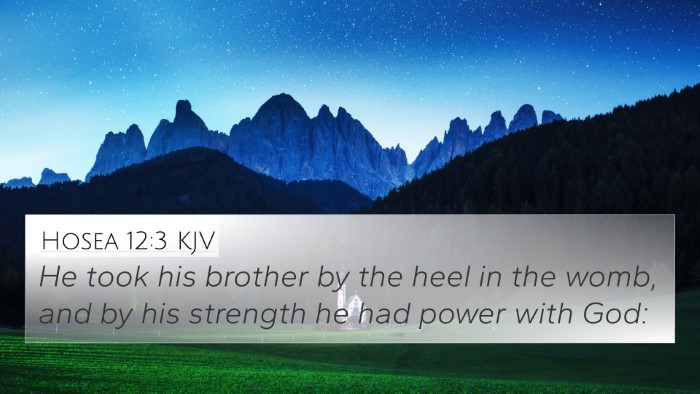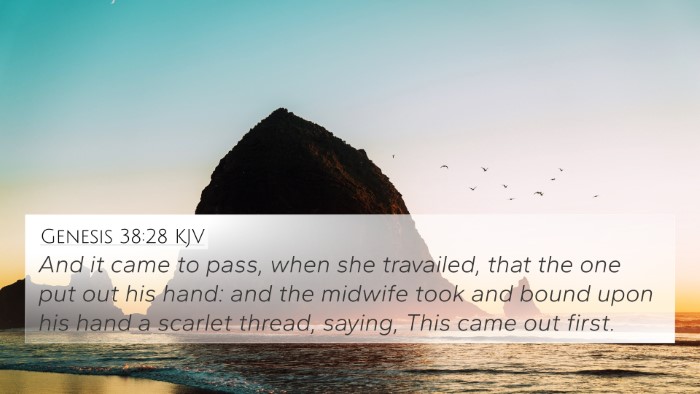Understanding Genesis 25:26
Genesis 25:26 states: “Afterward his brother came out, and his hand took hold of Esau’s heel; so his name was called Jacob. Isaac was sixty years old when she bore them.” This verse is rich in meaning and significance, particularly concerning the birth of Esau and Jacob and the implications of their names and actions.
Meaning and Interpretation
This verse marks a pivotal moment in the narrative of Genesis, introducing Jacob and Esau, the twins born to Isaac and Rebekah. The naming of Jacob, which means 'supplanter' or 'holder of the heel', foreshadows his later actions in the biblical account. The imagery of Jacob holding onto Esau's heel symbolizes his struggle for the birthright and leads to deeper reflections on their tumultuous relationship.
Commentary Insights
- Matthew Henry Commentary:
Henry highlights the significance of the twins’ birth order, emphasizing how Jacob’s grasping of Esau’s heel reflects a struggle for dominance and the themes of rivalry and conflict that characterize their lives. This moment symbolizes the broader theological implications regarding God's choice and election, as seen throughout Scripture.
- Albert Barnes Notes:
Barnes posits that the name Jacob was not merely a label but a prophetic indication of his future. This event illustrates the intensity of their relationship, where Jacob’s action signifies not just sibling rivalry but a divine plan in motion, hinting at the eventual transfer of the birthright and blessing.
- Adam Clarke Commentary:
Clarke remarks on the cultural significance of the names given to the twins. Esau, meaning "hairy," reflects his outward characteristics, while Jacob's name suggests a deeper, cunning nature. This commentary draws attention to the implications of names in biblical texts, indicating the spiritual and moral character of these figures. Clarke also discusses the prophecy concerning the younger brother serving the older, aligning with the themes of divine providence.
Cross-References
To understand Genesis 25:26 further, we can examine several related Bible verses that provide context and deepen the reader’s insights:
- Genesis 27:36: Esau expresses his pain over Jacob taking his blessing.
- Romans 9:12: Paul references God’s choice of Jacob over Esau.
- Malachi 1:2-3: God’s love for Jacob and hatred for Esau is mentioned, indicating divine favor.
- Hebrews 12:16-17: A warning about the consequences of Esau’s actions regarding his birthright.
- Genesis 32:28: Jacob’s name is changed to Israel, representing his struggle with God and man.
- Genesis 25:29-34: Jacob sells lentil stew to Esau in exchange for his birthright, highlighting the significance of Genesis 25:26.
- Galatians 4:22-23: An analogy between Sarah and Hagar can be drawn, paralleling the themes of conflict and choice.
Jesus and the Sons of Isaac
In the New Testament, Jesus makes reference to the patriarchs, and understanding the dynamics between Jacob and Esau gives depth to Jesus’ teachings about family and relationships, particularly within a context of choice and divine purpose.
Thematic Connections
Genesis 25:26 engages themes of:
- Birthright and Blessing: The importance of the firstborn, as seen in the narrative of Esau and Jacob.
- Divine Election: God's sovereign choice that transcends human understanding.
- Sibling Rivalry: The recurring theme of conflict among brothers in biblical narratives, inviting comparisons with Cain and Abel.
- Identity and Purpose: The names given to scripture figures shaping their destinies within God's plan.
Tools for Bible Cross-Referencing
For deeper study, consider the following tools for cross-referencing biblical texts:
- Bible Concordance: An invaluable resource for finding specific verses and exploring related passages.
- Bible Cross-Reference Guide: A comprehensive guide helps identify connections between individual verses.
- Cross Reference Bible Study: Methods to systematically explore scripture relationships across the text.
- Bible Reference Resources: Printed and online resources that can aid in understanding biblical context.
- Comprehensive Bible Cross-Reference Materials: Additional materials explore themes and cross-references extensively, enriching the study experience.
Conclusion
In conclusion, Genesis 25:26 is not merely a historical narrative but a rich theological statement that invites readers to explore deeper connections throughout Scripture. By cross-referencing this verse with other passages, we can gain a fuller understanding of God's purposes and the intricate relationships that shape biblical history.





